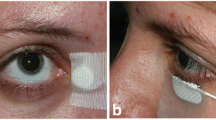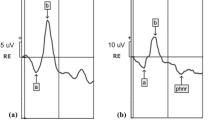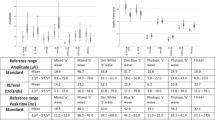Abstract
Purpose: Assess ERG responses recorded with skin electrodes in children with retinal dystrophies. Method: ERG responses were recorded using skin electrodes in 17 healthy children and 43 paediatric patients with retinal dystrophy. Subjects were aged 4–14 years. ERG responses were recorded to full-field stimuli similar to those recommended in the ISCEV standard. The type of retinal dystrophy was classified on the basis of standard clinical criteria and the ERG responses were compared with those of the age-matched controls. Results: ERG responses were abnormal in every patient. The specific type of ERG abnormality was also consistent with the clinical findings in the majority of patients. Rod responses were abnormal in every patient with a rod–cone dystrophy and cone responses were also abnormal in the majority of patients. Those patients with cone dystrophy or rod monochromatism had normal or near normal rod responses but sub-normal or absent cone responses. Patients with CSNB or XLRS had a sub-normal b-wave but normal amplitude a-wave. Conclusion: ERGs can be recorded successfully with skin electrodes in paediatric patients and responses can aid the diagnosis of the type of retinal dystrophy.
Similar content being viewed by others
References
Bradshaw K, Hansen N, Fulton A. Comparison of ERGs recorded with skin and corneal-contact electrodes in normal children and adults Doc Ophthalmol, 2004; 109: 43–55.
Marmor MF, Zrenner E Standard for clinical electroreti-nography (1999 update). Doc Ophthalmol 1998/1999; 97: 143–56.
Berson EL, Gouras P, Gunkel RD, Myrianthopoulos NC. Rod and cone responses in sex-linked retinitis pig-mentosa. Arch Ophthalmol 1969; 81: 215–35.
Arden GB, Carter RM, Hogg CR, Powell DJ, Ernst WJK, Clover GM, Lyness AL, Quinlan MP A modified ERG technique and the results obtained in X-linked retinitis pigmentosa. Br J Ophthalmol 1983; 67: 419–30.
Heckenlively JR. Cone dystrophies and dysfunction. In: Heckenlively JR, Arden GB, eds. Principles and practice of clinical electrophysiology of vision. Moser, 1991.
George NDL, Yates JWR, Moore AT. Clinical features in affected males with X-linked retinoschisis. Arch Ophthalmol 1996; 114: 274–80.
Miyake Y, Yagasaki K, Horiguchi M, Kawase Y, Kanda T. Congenital stationary night blindness with negative electroretinogram. Arch Ophthalmol 1986; 104: 1013–20.
Peachey NS, Fishman GA, Derlacki D, Brigell MG. Psychophysical and electroretinographic findings in X-linked juvenile retinoschisis. Arch Ophthalmol 1987; 105: 513–6.
Tremblay F, Laroch RG, Becker ID. The electro reti-nographic diagnosis of the incomplete form of congeni-tal stationary night blindness. Vision Res 1995; 16: 2383–93.
Bradshaw K, Allen L, Trump D, Hardcastle A, George N, Moore AT. A comparison of ERG abnormalities in XLRS and XLCSNB. Doc Ophthalmol, 2004; 108: 135–145.
Bradshaw K, George N, Moore AT, Trump D. Muta-tions of the XLRS1 gene cause abnormalities of photore-ceptor as well as inner retinal responses of the ERG. Doc Ophthalmol 1999; 98: 153–73.
Sieving PA, Bingham EL, Kemp J, Richards J, Hiriyan-na K. Juvenile X-linked retinoschisis from XLRS1 Arg213Trp mutation with preservation of the electroreti-nogram scotopic b-wave. Am J Ophthalmol 1999; 128: 179–84.
Author information
Authors and Affiliations
Rights and permissions
About this article
Cite this article
Meredith, S.P., Reddy, M.A., Allen, L.E. et al. Full-field ERG responses recorded with skin electrodes in paediatric patients with retinal dystrophy. Doc Ophthalmol 109, 57–66 (2004). https://doi.org/10.1007/s10633-004-1752-2
Issue Date:
DOI: https://doi.org/10.1007/s10633-004-1752-2




